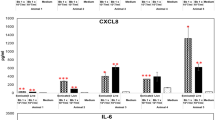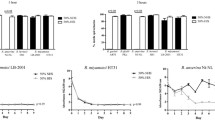Summary
The purpose of this study was to examine the structural alterations ofBorrelia burgdorferi when exposed to spinal fluid. Normal, mobile spirochetes were inoculated into spinal fluid, and the spirochetes were converted to cysts (spheroplast L-forms) after 1–24 h. When these cystic forms were transferred to a rich BSK-H medium, the cysts were converted back to normal, mobile spirochetes after incubation for 9 to 17 days. The cultures were examined by dark field microscopy (DFM), interference contrast microscopy (ICM) and transmission electron microscopy (TEM). When neuroborreliosis is suspected, it is necessary to realize thatB. burgdorferi can be present in a cystic form, and these cysts have to be recognized by microscopy. This study may also explain why cultivation of spinal fluid often is negative with respect toB. burgdorferi.
Similar content being viewed by others
References
Barbour, A. G., Fish, D.: The biological and social phenomenon of Lyme disease. Science 260 (1993) 1610–1616.
Luft, B. J., Steinman, C. R., Neimark, H. G., Muralidhar, B., Rush, T., Finkel, M. F., Kunkel, M., Dattwyler, R. J.: Invasion of the central nervous system byBorrelia burgdorferi in acute disseminated infection. JAMA 267 (1992) 1364–1367.
Stiernstedt, G.: Tick-borneBorrelia infection in Sweden. Scand. J. Infect. Dis. 45 (Suppl.) (1985) 1–70.
Christen, H. J., Hanefeld, F., Eiffert, H., Thomssen, R.: Epidemiology and clinical manifestations of Lyme borreliosis in childhood. A prospective multicentre study with special regard to neuroborreliosis. Acta Paediatrica Suppl. 82 (1993) 386.
Keller, T. L., Halperin, J. J., Whitman, M.: PCR detection ofBorrelia burgdorferi DNA in cerebrospinal fluid of Lyme neuroborreliosis patients. Neurology 42 (1992) 32–42.
Logigian, E. L., Kaplan, R. F., Steere, A. C.: Chronic neurological manifestations of Lyme disease. N. Engl. J. Med. 323 (1990) 1438–1444.
Halperin, J. J., Volkman, D. J., Wu, P.: Central nervous system abnormalities in Lyme neuroborreliosis. Neurology 41 (1991) 1571–1582.
Preac Mursic, V., Weber, K., Pfister, H. W., Wilske, B., Gross, B., Baumann, A., Prokop, J.: Survival ofBorrelia burgdorferi in antibiotically treated patients with Lyme borreliosis. Infection 17 (1989) 355–359.
Oksi, J., Marjamaki, M., Koski, K., Nikoskelainen, J., Viljanen, M. K.: Bilateral facial palsy and meningitis caused byBorrelia double infection. Lancet 345 (1995) 1583–1584.
Pfister, H. W., Preac Mursic, V., Wilske, B., Einhäupl, K. M., Weinberger, K.: Latent Lyme neuroborreliosis: presence ofBorrelia burgdorferi in the cerebrospinal fluid without concurrent inflammatory signs. Neurology 39 (1989) 1118–1120.
Karlsson, M., Hammers-Berggren, S., Lindquist, L., Stiernstedt, G., Svenungsson, B.: Comparison of intravenous penicillin G and oral doxycycline for treatment of Lyme neuroborreliosis. Neurology 44 (1994) 1203–1207.
Karlsson, M.: Aspects of the diagnosis of Lyme borreliosis. Scand. J. Infect. Dis. 67 (1990) (Suppl.) 1–59.
Åsbrink, E., Hovmark, A., Hederstedt, B.: The spirochetal etiology of acrodermatitis chronica atrophicans Herxheimer. Acta Derm. Venerol. 64 (1984) 506–512.
Pollack, R. J., Telford, S. R., Spielman, A.: Standardization of medium for culturing Lyme disease spirochetes. J. Clin. Microbiol. 31 (1993) 1251–1255.
Hammers-Berggren, S., Lebech, A. M., Karlsson, M., Svenungsson, B., Hansen, K., Stiernstedt, G.: Serological follow-up after treatment of patients with erythema migrans and neuroborreliosis. J. Clin. Microbiol. 32 (1994) 1519–1525.
Brorson, Ø., Brorson, S. H.: Transformation of cystic forms ofBorrelia burgdorferi to normal mobile spirochetes. Infection 25 (1997) 240–246.
Jobe, D. A., Callister, S. M., Schell, R. F.: Recovery ofBorrelia burgdorferi by filtration. J. Clin. Microbiol. 31 (1993) 1896–1897.
Brorson, S. H., Skjørten, F.: Mechanism for antigen detection on deplasticized epoxy sections. Micron 26 (1995) 301–310.
Brorson, S. H., Strøm, E. H., Skjørten, F.: Immunoelectron microscopy on epoxy sections without deplasticizing to detect glomerular immunoglobulin and complement deposits in renal diseases. APMIS 105 (1997) 139–149.
Garon, C. F., Dorward, D. W., Corwin, M. D.: Structural features ofBorrelia burgdorferi—the Lyme disease spirochete: silver staining for nucleic acids. Scanning Microsc. 3 (Suppl.) (1989) 109–115.
Bruck, D. K., Talbot, M. L., Cluss, R. G., Boothby, J. T.: Ultrastructural characterization of the stages of spheroplast preparation ofBorrelia burgdorferi. J. Microbiol. Methods 23 (1995) 219–228.
Schaller, M., Neubert, U.: Ultrastructure ofBorrelia burgdorferi after exposure to benzylpenicillin. Infection 22 (1994) 401–406.
Coyle, P. K., Deng, Z., Schutzer, S. E., Belman, A. L., Benach, J., Krupp, L. B., Luft, B.: Detection ofBorrelia-burgdorferi, antigens in cerebrospinal fluid. Neurology 43 (1993) 1093–1097.
Schutzer, S. E., Coyle, P. K., Belman, A. L., Golightly, M. G., Drulle, J.: Sequestration of antibody toBorrelia burgdorferi in immune complexes in seronegative Lyme disease. Lancet 335 (1990) 312–315.
Tatro, J. B., Romero, L. I., Beasley, D., Steere, A. C., Reichlin, S.:Borrelia burgdorferi andEscherichia coli lipopolysaccharides induce nitric oxide and interleukin-6 production in cultured rat brain cells. J. Infect. Dis. 169 (1994) 1014–1022.
Defosse, D. L., Johnson, R. C.:In vitro andin vivo induction of tumor necrosis factor alpha byBorrelia burgdorferi. Infect. Immun. 60 (1992) 1109–1113.
Miller, L. C., Isa, S., Vannier, E., Georgilis, K., Steere, A. C., Dinarello, C. A.: LiveBorrelia burgdorferi preferentially activate interleukin-1b gene expression and protein synthesis over the interleukin-1 receptor antagonist. J. Clin. Invest. 90 (1992) 906–912.
Hardin, J. A., Steere, A. C., Malawista, S. E.: Immune complexes and the evolution of Lyme arthritis. Dissemination and localisation of abnormal C1q binding activity. N. Engl. J. Med. 301 (1979) 1358–1363.
Høiby, N., Doring, G., Schiøtz, P. O.: The role of immune complexes in the pathogenesis of bacterial infections. Ann. Rev. Microbiol. 40 (1986) 29–53.
Beck, G., Benach, J. L., Habicht, G. S.: Isolation, preliminary chemical characterization, and biological activity ofBorrelia burgdorferi peptidoglycan. Biochem. Biophys. Res. Commun. 167 (1990) 89–95.
Radolf, J. D., Arndt, L. L., Akins, D. R., Curetty, L. L., Levi, M. E., Shen, Y., Davis, L. S., Norgard, M. V.:Treponema pallidum, andBorrelia burgdorferi lipoproteins and synthetic lipopeptides activate monocytes/macrophages. J. Immunol. 154 (1995) 2866–2877.
Sadziene, A., Rosa, P. A., Thompson, P. A., Hogan, D. M., Barbour, A. G.: Antibody-resistant mutants ofBorrelia burgdorferi: in vitro selection and characterization. J. Exp. Med. 176 (1992) 799–809.
Burgdorfer, W., Schwan, T. G.: Lyme borreliosis: a relapsing feverlike disease? Scand. J. Infect. Dis. 77 (1991) (Suppl.) 17–22.
MacDonald, A. B.: Concurrent neocortical borreliosis and Alzheimer’s disease. Ann. N. Y. Acad. Sci. 539 (1988) 468–470.
Hulínská, D., Barták, P., Hercogová, J., Hancil, J., Basta, J., Schramlová, J.: Electron microscopy of Langerhans cells andBorrelia burgdorferi in Lyme disease patients. Zbl. Bakt. 280 (1994) 348–359.
Kersten, A., Poitschek, S., Rauch, S., Aberer, E.: Effects of penicillin, ceftriaxone, and doxycycline on morphology ofBorrelia burgdorferi. Antimicrob. Agents Chemother. 39 (1995) 1127–1133.
Preac Mursic, V., Wanner, G., Reinhardt, S., Wilske, B., Busch, U., Marget, W.: Formation and cultivation ofBorrelia burgdorferi spheroplast-L-form variants. Infection 24 (1996) 218–226.
Grüner, E. S.: Complement evasion by the Lyme disease spirocheteBorrelia burgdorferi grown in host-derived tissue co-cultures: role of fibronectin in complement-resistance. Experientia 52 (1996) 364–372.
Georgilis, K., Peacocke, M., Klempner, M. S.: Fibroblasts protect the Lyme disease spirochete,Borrelia burgdorferi, from ceftriaxonein vitro. J. Infect. Dis. 166 (1992) 440–444.
Priem, S., Rittig, M. G., Kamradt, T., Burmester, G. R., Krause, A. J.: An optimized PCR leads to rapid and highly sensitive detection ofBorrelia burgdorferi in patients with Lyme borreliosis. Clin. Microbiol. 35 (1997) 685–690.
Peters, D. J., Benach, J. L.:Borrelia burgdorferi adherence and injury to undifferentiated and differentiated neural cellsin vitro. J. Infect. Dis. 176 (1997) 470–477.
Author information
Authors and Affiliations
Rights and permissions
About this article
Cite this article
Brorson, Ø., Brorson, S.H. In vitro conversion ofBorrelia burgdorferi to cystic forms in spinal fluid, and transformation to mobile spirochetes by incubation in BSK-H medium. Infection 26, 144–150 (1998). https://doi.org/10.1007/BF02771839
Received:
Accepted:
Issue Date:
DOI: https://doi.org/10.1007/BF02771839




